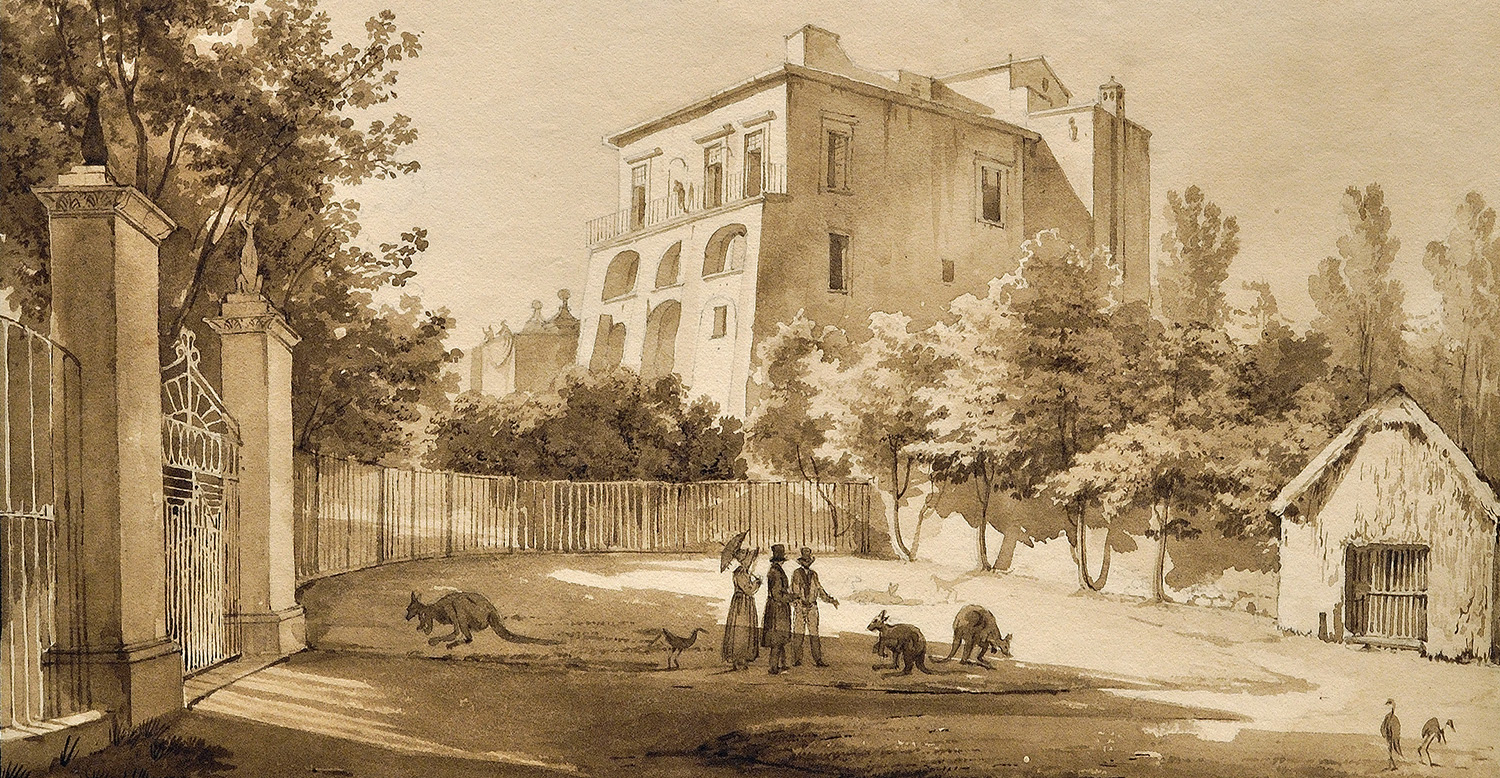GIGANTE’S MECHANICAL EYE SEES KANGAROOS

These graphite and wash drawings were made using an optical device called a camera lucida (literally “light room”), patented in 1806. When these works were made, this was cutting edge technology and Gigante was an early adopter. The camera lucida uses lenses and a half-silvered mirror at a forty-five-degree angle through which the artist sees what is in front of them projected onto the paper and can trace that image. An SLR camera does a similar thing but what it sees is recorded on light sensitive material. When these works were made, the camera lucida (with a skilled artist’s hand using it) was the most accurate way to empirically record the visual world. The perspective and scale of a drawing would be like that of a photograph. A skilled draughtsperson could render the same scene without a camera lucida, but they would be neither as fast, nor as accurate.
Gigante was part of an informal group of Neapolitan painters called the School of Posillipo after their waterfront neighbourhood. This group specialized in landscapes which sold well to the aristocrats making the grand tour of Italy during the Age of Enlightenment. When visiting Naples, wealthy Protestants from northern Europe would be less inclined to purchase art with Catholic imagery but Posillipo school landscapes were more like postcards recording the sights to take home. The way these artists framed a view and what they chose to depict help inform the language of landscape art. These artworks communicated a new way to see the world that still guides our choices when we take a picture with our phones.
![Gigante, Untitled [View of Kangaroos at the Villa Floridiana]](https://artgalleryofnovascotia.ca/sites/default/files/2016_155_2.jpg) The scene Gigante rendered is of an impressively gated and fenced enclosure below a large villa. In the late day shadow, we see two men and a woman with a parasol; near them are three kangaroos and several birds, possibly peacocks. The perspective and depiction of light and shadow make it easy for the viewer to imagine witnessing the scene Gigante has fixed it in time on paper.
The scene Gigante rendered is of an impressively gated and fenced enclosure below a large villa. In the late day shadow, we see two men and a woman with a parasol; near them are three kangaroos and several birds, possibly peacocks. The perspective and depiction of light and shadow make it easy for the viewer to imagine witnessing the scene Gigante has fixed it in time on paper.
The woman is carrying a parasol, and this instantly establishes that these people are of a certain class. It is a world of luxury and leisure. The Villa Floridiana was renovated from 1817 to 1819 by King Ferdinand I to house his partner Lucia Migliaccio, duchess of Floridia. There was a whiff of scandal about this marriage. The Queen, Maria Carolina (sister of Marie Antoinette) had died less than three months before 63-year-old Ferdinand I married 43-year-old Lucia (who for class reasons was never recognized as a queen). The Floridiana was a large park-like private enclave created as a love token for Lucia. You can visit it today as one of the villas is home to The National Museum of Ceramics, Naples. Gigante’s renowned career brought him into the employ of many European royals and a street near the Villa Floridiana bears his name today.
Gigante’s wash drawings are sepia toned which automatically makes them look dusty and historical to contemporary eyes. In their time the suite of drawings must have been like a feature spread in Architectural Digest. They documented how the rich and famous were living in a new enclave outside Naples. The Vomero hill where Villa Floridiana sits was a chic new address in the 1820s. The Villa had kangaroos! Australia had only been settled by the British in 1788 and these exotic animals had been captured and survived a long sea voyage to enliven the grounds of the Villa Floridiana.
Ferdinand I died in January of 1825 and Lucia died in April 1826, the year this suite of works was made. Under what circumstances was a then 22-year-old Gigante at this Villa that year? Did the deaths of these royals create an open-house situation where the public got to see how the other half lived? This suite of works exudes a sense of a transient moments of beauty and pleasure captured in amber.

